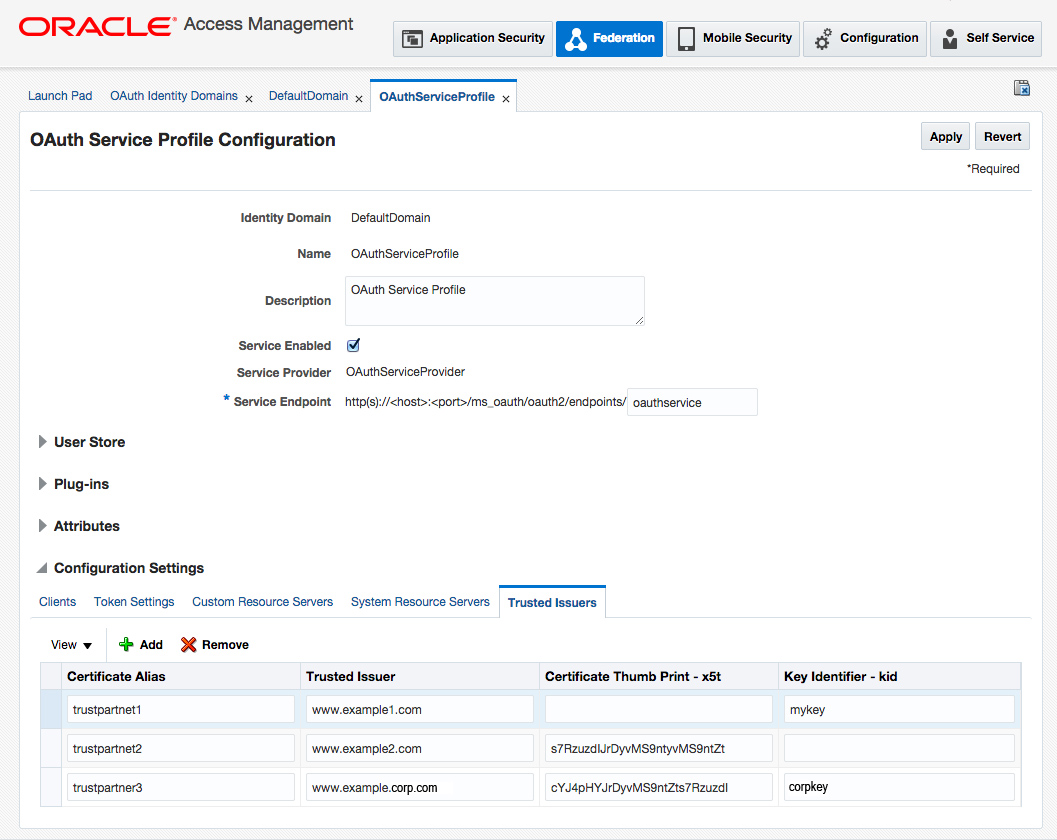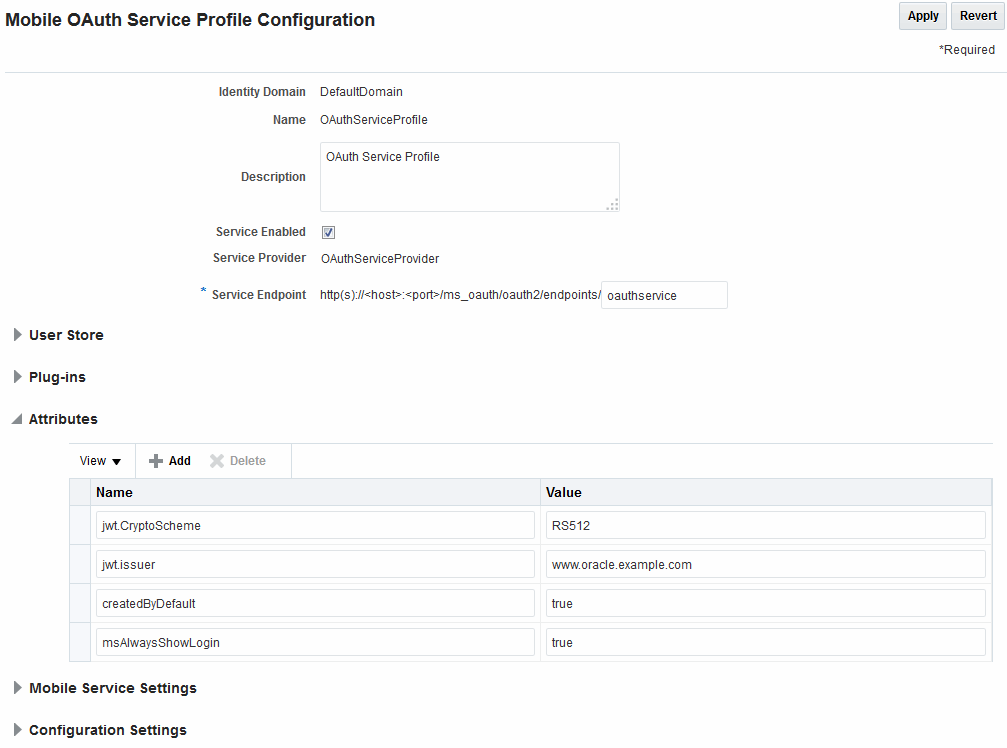53.4 Configuring OAuth Services for Third-Party JWT Bearer Assertions
Create a separate keystore for each Service Profile that needs its own signing certificate. This section covers the following topics:
53.4.1 Default Service Profile Keystore
The default Service Profile (OAuthServiceProfile) created in the DefaultDomain uses the Java Keystore (JKS) included with Oracle Access Management.
The role of the Service Profile is described in Service Profiles - Identity Federation and OAuth Services The OAuthServiceProfile consists of the following files:
Table 53-6 Default OAuth JKS Keystore File and Settings File
| File | Path |
|---|---|
|
JKS keystore file |
|
|
Keystore settings file |
|
Note:
Oracle Web Services Manager also uses the default-keystore.jks service. For details see About the Oracle Web Services Manager Keystore (default-keystore.jks).
You can use the following Java keytool command to list all of the private key and certificate information in the default keystore (default-keystore.jks).
keytool -list -keystore default-keystore.jks
Note:
When a new key is added to the OAM keystore, the OAM server needs to be restarted since keystore changes are not automatically refreshed.
53.4.2 Finding Credentials with Oracle Enterprise Manager Fusion Middleware Control Console
You can find the keystore credential with Oracle Enterprise Manager Fusion Middleware Control Console.
To find the keystore credential:
53.4.3 Creating a Non-Default Keystore for a Service Profile
You can create a non-default keystore for a Service Profile.
The steps in this section describe about:
Note:
Any changes made during this procedure require a restart of the OAM server.
53.4.3.1 Creating a Seperate Keystore to Store Third-Party Certificates
You can create a new Java Keystore (JKS) using the keytool utility that is distributed with the Java JDK.
To create a new JKS:
53.4.3.2 Loading or Importing the Certificates Into the Keystore
You can use the keytool utility to import the certificates into the keystore.
To import the cerftificates:
53.4.3.3 Adding the Keystore Instance to jps-config.xml
You can configure the keystore service and update the credential store so that OAM can read the keystore and keys correctly.
In the jps-config.xml keystore settings file, add the following new keystore service instance in the <serviceInstances> element.
53.4.3.4 Creating a CSF Entry for the Keystore Service Instance
You can create the necessary Credential Store Framework (CSF) entries using the WLST commands.
Following are the WLST commands. Restart the server when you are done.
createCred(map="oracle.wsm.security", key="sign_csf_key", user="alias_name", password=keystore_password, desc="Description of the signing key credential")
createCred(map="oracle.wsm.security", key="enc_csf_key", user="alias_name", password=keystore_password, desc="Description of the encryption key credential")
createCred(map="oracle.wsm.security", key="keystore_csf_key", user="oauth", password=keystore_password, desc="Description of the keystore credential")
Where:
-
sign_csf_key= the password for the signing key -
alias_name= the alias name for the key -
keystore_password= the keystore password -
enc_csf_key= the password for the encryption key -
keystore_csf_key= the password for the keystore
Creating Credential Store Entries
createCred(map="oracle.wsm.security", key="oauth-sign-csf-key", user="ms-oauth-key", password=passwordxyz, desc="Signing key credential") createCred(map="oracle.wsm.security", key="oauth-enc-csf-key", user="ms-oauth-key", password=passwordxyz, desc="Encryption key credential") createCred(map="oracle.wsm.security", key="keystore_csf_key", user="oauth", password=passwordxyz, desc="Keystore credential")
53.4.3.5 Adding the Provider Service Name to the Service Profile
You can apply the updated configuration to the Service Profile.
See Creating a Service Profile if you have not yet created an OAuth Service Profile for the third-party service.
53.4.4 Configuring a Third-Party JWT Trust Issuer
You can configure OAuth Services to support specific JSON Web Token (JWT) issuers.
All Trusted Issuers must be defined so the OAM Server can validate the token, the thumbprint (x5t) and the key identifier based on this configuration. If there is a trusted entry already available with the same claim, header values and alias name, that entry will be used.
Figure 53-4 is a screenshot of the OAuth Services Service Profile Configuration Page where Trusted Issuers are defined under the Configuration Settings heading. Three Trusted Issuers are configured in it and the following is true of these configurations.
-
If a request comes with an assertion in which the Trusted Issuer is "www.example1.com", the kid header is "mykey" and there is no x5t header, the runtime uses the certificate with the "trustpartner1" alias name.
-
If a request comes with an assertion in which the Trusted Issuer is "www.example2.com", the value of the x5t header is "s7RzuzdlJrDyvMS9ntyvMS9ntZt" and there is no kid header, the runtime uses the certificate with the "trustpartner2" alias name.
-
If a request comes with an assertion in which the Trusted Issuer is "www.example.corp.com", the value of the kid header is "corpkey" and the value of the x5t header is "cYJ4pHYJrDYvMS9ntZts7Rzuzdl", the runtime uses the certificate with the "trustpartner3" alias name.
Figure 53-4 OAuth Services Service Profile Configuration Page

Description of "Figure 53-4 OAuth Services Service Profile Configuration Page"
